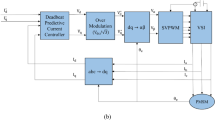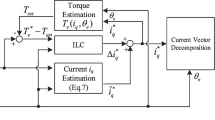Abstract
The compound architecture of CMAC (Cerebellar Model Articulation Controller) and PD (Proportional-Derivative) can effectively reduce the loading error and restrain the surplus torque of electric load simulators. But due to its generalization ability, the CMAC controller has an unsmooth output, which leads to the motor vibration even the divergence of control system. The unsmooth problem of CMAC is analyzed in this paper and a novel scalar cost function of CMAC is proposed, which consists of an error item and a weight smoothing item to guarantee fast learning capacity and improved output smoothness of CMAC. With the novel scalar cost function, a compound torque controller of PD and smooth CMAC is derived by using the gradient descent algorithm. Both the simulation and experimental results demonstrate that the novel CMAC-PD compound controller can effectively improve the output smoothness of the electric load simulator, eliminate the surplus torque and assure the stability of system as well.
Similar content being viewed by others
References
Z. T. Ren and Z. X. Jiao, “Design of motor-drive load simulator with small torque outputs,” Journal of Beijing University of Aeronautics and Astronautics, vol. 29, no. 1, pp. 91–94, February 2003.
J. Y. Yao, Z. X. Jiao, and B. Yao, “Robust control for static loading of electro-hydraulic load simulator with friction compensation,” Chinese Journal of Aeronautics, vol. 25, no. 6, pp. 954–962, October 2012.
X. J. Wang, S. P. Wang, and B. Yao, “Adaptive robust torque control of electric load simulator with strong position coupling disturbance,” International Journal of Control, Automation and Systems, vol. 11, no. 2, pp. 325–332, April 2013.
J. F. Wang, L. H. Liang, and S. T. Zhang, “Application of H8 control based on mixed sensitivity in the electro-hydraulic load simulator,” Proc. of the IEEE Int. Conf. on Mechatronics and Automation, pp. 2991–2996, 2007.
B. Yang and Z. Wang, “Structure and algorithm of hybrid control in cerebella model articulation controller for electric loading system,” Control Theory & Applications, vol. 28, no. 6, pp. 827–833, June 2011.
C. F. Hsu, C. M. Chung, and C. M. Lin, and C. Y. Hsu, “Adaptive CMAC neural control of chaotic systems with a PI-type learning algorithm,” Expert System with Applications, vol. 36, no. 9, pp. 11836–11843, November 2009.
L. His-Kuang, T. Cheng-Hung, and L. Hung-Ching, “CMAC neural network application for induction motor drives,” Proc. of the IEEE Int. Conf. on Systems, Man, and Cybernetics, pp. 2279–2284, 2011.
N. Pai, H. Yau, and T. Hung, and C. Hung, “Application of CMAC neural network to solar energy heliostat field fault diagnosis,” International Journal of Photoenergy, vol. 2013, pp. 1–8, 2013.
W. Sun, C. Wang, B. Dexu, S. N. Liu, B. Q. Wu, and M. H. Ouyang, “A fuzzy cerebellar model articulation controller based visual servo system for robot,” International Journal of Control, Automation and Systems, vol. 10, no. 2, pp. 430–436, April 2012.
T. W. Miller, R. P. Hewes, F. H. Glanz, and L. G. Kraft, “Real-time dynamic control of an industrial manipulator using a neural-network-based learning controller,” IEEE Trans. on Robot Autom, vol. 6, no. 1, pp. 1–9, February 1990.
J. C. Jan and H. Shih-Lin, “High-order MS CMAC neural network,” IEEE Trans. on Neural Networks, vol. 12, no. 3, pp. 598–603, May 2001.
Y. L. Fu, S. J. Li, and Y. S. Xiao, “Study on new neural network adaptive control of industrial manipulators based on desired compensation,” Proc. of the 7th World Congress on Intelligent Control and Automation, Chongqing, China, pp. 6983–6987, June 2008.
C. T. Chiang and T. S. Chiang, “A converged recurrent structure for CMAC_GBF and S_CMAC_GBF,” Proc. of IEEE International Symposium on Industrial Electronics, pp. 1876–1881, June 2007.
J. Pallotta and L. G. Kraft, “Two dimensional function learning using CMAC neural network with optimized weight smoothing,” Proc. of the American Control Conf., pp. 373–377, 1999.
G. Horváth and T. Szabó, “Kernel CMAC With Improved Capability,” IEEE Trans. on Systems, Man, and Cybernetics, Part B: Cybernetics, vol. 37, no. 1, pp. 124–138, February 2007.
Author information
Authors and Affiliations
Corresponding author
Rights and permissions
About this article
Cite this article
Yang, B., Han, H. A CMAC-PD compound torque controller with fast learning capacity and improved output smoothness for electric load simulator. Int. J. Control Autom. Syst. 12, 805–812 (2014). https://doi.org/10.1007/s12555-013-0368-2
Received:
Revised:
Accepted:
Published:
Issue Date:
DOI: https://doi.org/10.1007/s12555-013-0368-2




